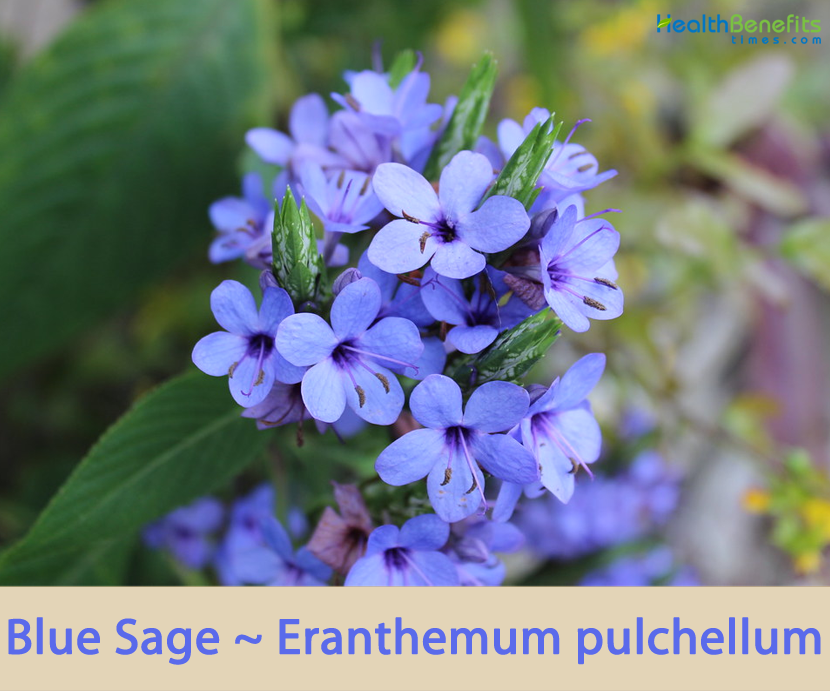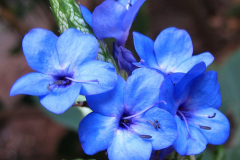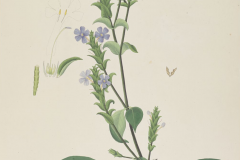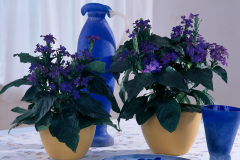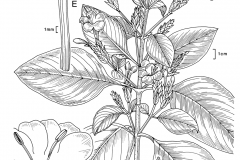| Blue Sage Quick Facts | |
|---|---|
| Name: | Blue Sage |
| Scientific Name: | Eranthemum pulchellum |
| Origin | Across South and South-East Asia mainly in Nepal, Sri Lanka, Bangladesh, Burma, Pakistan, Laos, Myanmar, Thailand, Vietnam and India |
| Colors | Initially green turning to brown as they mature |
| Shapes | Compressed bilocular capsules, dehiscent (they open spontaneously when ripe), 1.2-1.6 cm long, containing lentil-shaped seeds |
| Health benefits | Brain heath, digestion, fights bacterial & fungus infection, improves heart and skin health, lowers bad cholesterol, whooping cough, plethora and menstrual disorder |
| Name | Blue Sage |
|---|---|
| Scientific Name | Eranthemum pulchellum |
| Native | Across South and South-East Asia mainly in Nepal, Sri Lanka, Bangladesh, Burma, Pakistan, Laos, Myanmar, Thailand, Vietnam and India. It is naturalized in Queensland, Australia, but there is no clear evidence of naturalization elsewhere. |
| Common Names | Blue-sage, Blue Eranthemum |
| Name in Other Languages | Bengali: Kālōbāsaka (কালোবাসক) Chinese: Xǐ huācǎo (喜花草), Kě’ài huā (可爱花), Ài chūnhuā (爱春花), Lán huā zǐ(蓝花仔), Shǔ fù huàméi cǎo (鼠妇画眉草), Kě’ài huā (可爱花) English: Blue-sage, Blue Eranthemum Finnish: Korukäpy French: Pensée créole German: Blaue Frühlingsblume Hindi: Gulsham (गुलशाम), neelambaramu, neelamulli, neeli buti Nepali: Nila gāṭhē (निल गाठे) Portuguese: Camarão-azul, salva-azul Spanish: Azulejo Swedish: Safirbuske Tamil: Neelamulli (நீள முள்ளி) Telugu: Neelambaramu (నీలాంబరము) Vietnamese: Tinh hoa đẹp, tinh hoa xinh |
| Plant Growth Habit | Perennial, evergreen, semi-woody and much ramified shrub |
| Growing Climates | Semi-evergreen, montane, subtropical forest, dense moist mixed deciduous forest, moist gullies and by streams in dry, warm, broadleaved subtropical forest |
| Soil | Prefers fertile, acid, well-drained soils. It grows well in the area where it receives filtered sunlight or semi-shade, but the plant has a poor salt tolerance. Remove spent flowers to induce more blooming. |
| Plant Size | Between 1.2 to 1.8 m tall and 0.3 – 0.9 m wide |
| Leaf | Opposite simple, stalked, usually entire, elliptic or ovate-elliptic, 10-24 cm long and 4.5-8 cm wide, basally narrowed, prominently nerved, lateral nerves about 10 pairs, long pointed, glabrous or ± hairy on nerves beneath, entire or crenulate, acute-acuminate. Petioles are 2-10 mm long |
| Flowering season | February-April |
| Flower | Blue, purple, violet or purplish-white 2.5-3 cm long at branch-ends or in leaf-axils, in simple or branched dense 2-4 cm long spikes. Flower tube is cylindrical, more than twice as long as or equal patent limb lobes, overlapping. Calyx lobes are sub equal, linear-lanceolate, c. 6 mm long, minutely pubescent. Corolla narrow, 2 cm long, glabrous, dilated near the top, lobe oblique, lobes ± equal, patent, 1 cm long, obtuse |
| Fruit Shape & Size | Compressed bilocular capsules, dehiscent (they open spontaneously when ripe), 1.2-1.6 cm long, containing lentil-shaped seeds |
| Fruit Color | Initially green turning to brown as they mature |
| Seed | Seeds are mucilaginous hairy, supported on retinacula. |
| Plant Parts Used | Leaf |
| Propagation | Softwood cuttings |
| Health benefits |
|
| Other Facts |
|
Plant Description
Blue Sage is a perennial, evergreen, semi-woody and much ramified shrub that normally grows between 1.2 to 1.8 m tall and 0.3 – 0.9 m wide. It is found growing in semi-evergreen, montane, subtropical forest, dense moist mixed deciduous forest, and moist gullies and by streams in dry, warm, broadleaved subtropical forest. The plant prefers fertile, acid, well-drained soils. It grows well in the area where it receives filtered sunlight or semi-shade, but the plant has a poor salt tolerance. Remove spent flowers to induce more blooming. It is usually kept lower and bushier through pruning. Light shade is preferred in a garden; in a greenhouse it needs warm conditions. It is easily propagated from cuttings.
Leaves
Leaves are opposite simple, stalked, usually entire, elliptic or ovate-elliptic, 10-24 cm long and 4.5-8 cm wide, basally narrowed, prominently nerved, lateral nerves about 10 pairs, long pointed, glabrous or ± hairy on nerves beneath, entire or crenulate, acute-acuminate. Petioles are 2-10 mm long. Scars resembling stipular scars are visible between the petiolar bases on each pair of leaves.
| Leaf arrangement | Opposite/subopposite |
| Leaf type | Simple |
| Leaf margin | Serrate |
| Leaf shape | Elliptic (oval) |
| Leaf venation | Pinnate |
| Leaf type and persistence | Evergreen |
| Leaf blade length | 2 to 4 inches |
| Leaf color | Green |
| Fall color | No fall color change |
| Fall characteristic | Not showy |
Flowers
Flowers are blue, purple, violet or purplish-white 2.5-3 cm long at branch-ends or in leaf-axils, in simple or branched dense 2-4 cm long spikes. Flower tube is cylindrical, more than twice as long as or equal patent limb lobes, overlapping. Calyx lobes are sub equal, linear-lanceolate, c. 6 mm long, minutely pubescent. Corolla narrow, 2 cm long, glabrous, dilated near the top, lobe oblique, lobes ± equal, patent, ca. 1 cm long, obtuse. Fertile stamens are 2 with narrowly oblong, anthers, protruding out. Flowering normally takes place in between February-April.
| Flower color | Blue |
| Flower characteristic | Winter flowering |
Fruit
Fertile flowers are followed by compressed bilocular capsules, dehiscent (they open spontaneously when ripe), 1.2-1.6 cm long, containing lentil-shaped seeds. Fruits are initially green when young turning to brown as they mature. Seeds are mucilaginous hairy, supported on retinacula. It reproduces by seed and by herbaceous cutting in spring in sandy soil kept humid at a temperature of 24-26 °C; it easily self-disseminates, so much as to have naturalized in many tropical areas.
| Fruit shape | Oval |
| Fruit length | Less than .5 inch |
| Fruit cover | Dry or hard |
| Fruit color | Brown |
| Fruit characteristic | Inconspicuous and not showy |
Health benefits of Blue Sage
Listed below are some of the common health benefits of using blue sage
1. Promote mindfulness
If you’re like most people, you’re probably always on the go. You’re juggling work, family, and social obligations, and it feels like there’s never enough time in the day to get everything done. Blue sage is one herb that can help promote mindfulness, allowing you to find peace and calm in even the busiest of lives.
2. Reduces Stress and Anxiety
Blue Sage has long been used as a natural remedy for reducing stress and anxiety. The smoke from sage is said to help calm the mind and promote feelings of peace of mind.
3. Improve headaches and insomnia
According to the Mayo Clinic, headaches are one of the most common health problems, affecting nearly half of all adults. Additionally, insomnia is a sleep disorder that affects an estimated 30-40% of adults in the United States. Fortunately, there are steps you can take to help improve both headaches and insomnia. One of the common steps is using blue sage. They have been shown to be effective in reducing the frequency and severity of headaches, as well as improving sleep quality.
4. Relaxes the Nervous System
Blue Sage smoke has long been used to relax the nervous system and promote feelings of calm and peace. It can be helpful in reducing stress and anxiety levels.
5. Promotes Mental Clarity
Sage smoke is said to help promote mental clarity and focus. It can be helpful in improving concentration and aiding in meditation practices.
6. Repel Insects
If you are in search for a natural way to repel insects this summer, then blue sage may be the answer. Recent studies have shown that blue sage is an effective repellent against mosquitoes, black flies, and other biting insects. You can find blue sage at most health food stores.
Besides, you can also combine some other herbs such as dragon blood or eucalyptus to increase the effectiveness in repelling mosquitoes and other harmful insects.
7. Improves Sleep Quality
Blue Sage smoke is said to help improve sleep quality and duration. It can be helpful in promoting a sense of calm and relaxation before bed.
8. Detoxifies the Body
Blue Sage smoke is said to be able to help detoxify the body of harmful toxins and pollutants. This can be helpful in cleansing the body before undertaking a health or detoxification program.
9. Used as a Holy Herb
Blue sage is often considered a holy herb and is used in many spiritual ceremonies and rituals. It can be used to help connect with the divine and promote feelings of spiritual enlightenment.
10. Cares for the Mental Body
Blue Sage smoke is said to help care for the mental body, promoting positive thoughts and emotions. It can be helpful in preventing negative thinking and promoting a positive attitude.
11. Antimicrobial Properties
Blue Sage smoke is said to have antimicrobial properties, which can help to protect you from harmful bacteria and viruses.
12. Calms the Mind
The smoke from Blue Sage is said to calm the mind and help to reduce stress and anxiety levels. It can be helpful in promoting a sense of peace and tranquility.
13. Helps Manifest Wishes
Blue Sage smoke is said to help manifest your wishes and dreams into reality. With clear intentions and focus, sage smoke can help to promote positive change in your life.
14. Energizes the Body
The smoke from Blue Sage helps to energize the body and help to improve your overall health and wellbeing. It can be helpful in boosting your energy levels and vitality.
15. Purifies the Soul
Blue Sage smoke is said to purify the soul, promoting feelings of inner peace and spiritual enlightenment. It can be helpful in cleansing the mind and soul of negative thoughts and emotions.
Traditional uses and benefits of Blue Sage
- Roots, stems and leaves decoction is antimicrobial, antiseptic, used for wounds, ulcers.
- It has also been seen as a remedy for headache relief and minor nerve pain such as muscle cramps.
- It has been used for thousands of years by Mazatec shamans in central Mexico in order to induce visions for spiritual, divinatory, and healing purposes.
- It is added to tobacco or cannabis, with the purpose of calming nerves and promoting relaxation.
- Blue Sage improves gut health.
- It’s high in antioxidants, improves brain heath, aids digestion, fights bacterial & fungus infection, improves heart and skin health and lowers bad cholesterol.
- Leaves are used in whooping cough, plethora and menstrual disorder.
- Paste is made from the leaves of the plant and is applied on the boils to treat them.
- Decoction prepared from the leaves of the plant is used for aphthae.
- Paste prepared from the leaves is used for wounds and ulcers.
Precautions
- Very few people are allergic to blue sage, but if you notice some signs such as difficulty breathing or a rash when burning them then it is best that we stop using this plant.
- Blue sage is a very powerful herb that’s often used in traditional rituals. When burned, it produces large amounts of smoke which may cause problems with breathing, and opening up windows can help keep things better ventilated for you while performing your ceremony or spell work!
- Pregnant women and newborns avoid exposure to smoky environments for long periods of time.
- If you are suffering from respiratory diseases such as pneumonia or asthma, please do not use this product too often.
- To avoid fires, it is important to keep away from flammable items such as curtains.
References:
https://www.itis.gov/servlet/SingleRpt/SingleRpt?search_topic=TSN&search_value=502346#null
https://www.cabi.org/isc/datasheet/28666130#toPictures
https://www.missouribotanicalgarden.org/PlantFinder/PlantFinderDetails.aspx?taxonid=291309
https://gd.eppo.int/taxon/EAUNV
https://indiabiodiversity.org/species/show/229656
http://www.theplantlist.org/tpl1.1/record/kew-2791833
http://www.flowersofindia.net/catalog/slides/Blue%20Sage.html
https://en.wikipedia.org/wiki/Eranthemum_pulchellum
https://www.nparks.gov.sg/florafaunaweb/flora/6/4/6426
https://www.wikidata.org/wiki/Q15320545
https://hort.ifas.ufl.edu/database/documents/pdf/shrub_fact_sheets/erapula.pdf
https://www.nparks.gov.sg/florafaunaweb/flora/6/4/6426
https://plants.usda.gov/home/plantProfile?symbol=ERPU18


